Subtotal: $
Checkout-

Endangered Habitat
-

The Pen and the Keyboard
-

Meet a True Story
-

A poem for my son about grace
-

Editors’ Picks Issue 15
-

The Soul of Work
-

Go On, Inner Man
-

Viktor Frankl
-

The Joys of Tech Asceticism
-

Readers Respond: Issue 15
-

Family and Friends
-

How to Homestead a Hermitage
-

Awake the Harp
-

The Ministry of Reconciliation
-

The Immortality Machine
-

The Immortality Delusion
-

Simulating Religion
-

Insight: Finding Someone to Worship
-

The Pencil Box
-

Why Children Need White Space
-

Insight: Friedrich Froebel
-

The Technology of Gender
-

Digging Deeper: Issue 15
-

The Gods of Progress
-

Anabaptist Technology
-

Your Neighbor Lives Next Door
-

Insight: Why I Am Not Going to Buy a Computer

The Perfect Tool
On a Kansas farm, Jack and Amy Baumgartner are crafting a family.
By Susannah Black Roberts
January 29, 2018
Next Article:
Explore Other Articles:
Jack Baumgartner starts his day at 4:30. His wife and four children are still asleep, and early on a November morning, outside his tin-roofed house on the plains near Wichita, Kansas, it’s still dark. But there’s a lot to do. “Downstairs,” he says, “I start the hot water for coffee. I stir the coals in the wood stove we heat our home with, remove some ashes, and place two mulberry logs on the embers to ignite. This is priestly work and an art near to my heart, maintaining a fire for my family. It is a part of my worship.”
Baumgartner, age forty-two, is a farmer. He’s also a woodworker, painter, musician, and puppeteer. “I have invested a lot in each area over time,” he told the writer Elizabeth Duffy in a 2014 interview, “so I feel comfortable in each realm.” This November morning, he brings his coffee and homemade bagel – his wife makes them – into the insulated garage next to the house that he uses as a studio. He’s working on a block of linoleum, carving an image: he’s a printmaker as well. Some of these he sells from the Etsy shop that he and his wife use to market their goods: his prints and turned wooden bowls, her goat’s-milk soap.
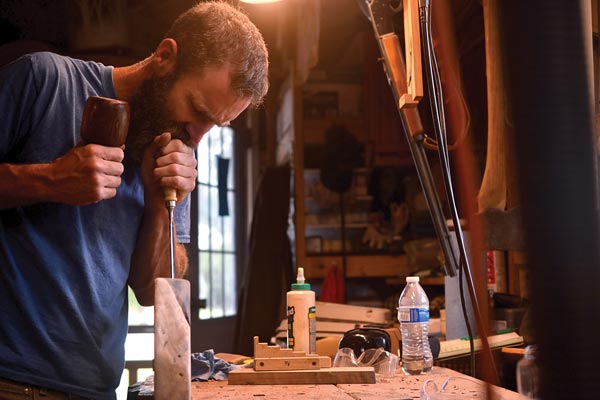
“I am chiseling a socket for a butterfly joint on the edge of a walnut table. Popularized by the Japanese American woodworker George Nakashima, the butterfly joint is used to bind together a crack or split in a piece of wood, allowing us to showcase its natural beauty.” —Jack Baumgartner
Until a couple of years ago, just before their fourth child was born, Amy, Jack’s wife, was working as a Presbyterian minister in Wichita. Jack was running the farm and his growing woodworking business and homeschooling the kids (the oldest is ten). But she left her job so that, as he describes it, “she could be a mom, finally.” It wasn’t easy. “As we were making the transition to losing the bulk of our financial security,” he says, “there was a lot of questioning from family and acquaintances. ‘How are you guys going to survive?’”
The answer to that question is the story of their days: they’re living on a patchworked domestic economy that takes a great deal of human energy, a great deal of commitment, and a great deal of creativity. The woodworking brings in the most money – later on that day, he’ll finish a custom poker table he’s making for a lodge in Montana – but the farming supplies much of the food. Before he can get to work on the poker table, his chores include checking the health of an ailing ewe-lamb; Amy milks the goats; the children collect eggs.
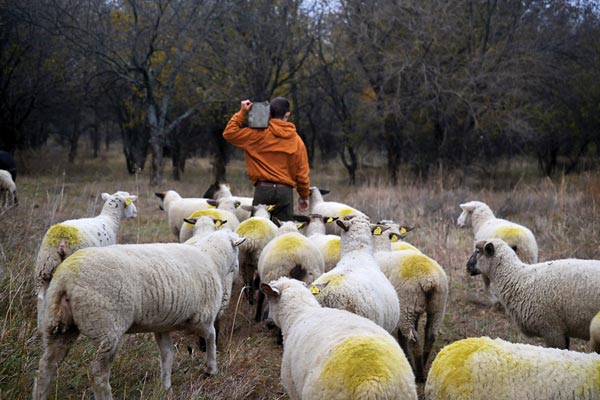
“My apprentice Wyatt Rickles feeds our ewes. He came to learn woodworking skills, but wished to help out with the farm chores while he was with us. I call the ewes my priests of the land.” —Jack Baumgartner
He feeds the pigs, stepping carefully over the electric fence, racing to reach the feeding pans before the pigs reach him. “I have to win,” he says, “or I can’t get the food past their greedy heads and bodies smashing into my legs and crowded around the plastic tubs. The kids don’t get to feed the pigs unless we have spoiled vegetables from my friend’s farm down the road. Then they hurl them over the fence at the pigs, laughing.”
It’s a way of life that integrates work and family. “I once read about the effects of the industrial revolution on families,” says Baumgartner, “about how homes were once the primary place of industry; maybe a shop on the ground floor and living quarters above. This was the playing field where life happened. Home was a perpetual bustle of life and community. I work long hours, but I am home and my children and my wife have access to me and I to them. We live together, not apart.”
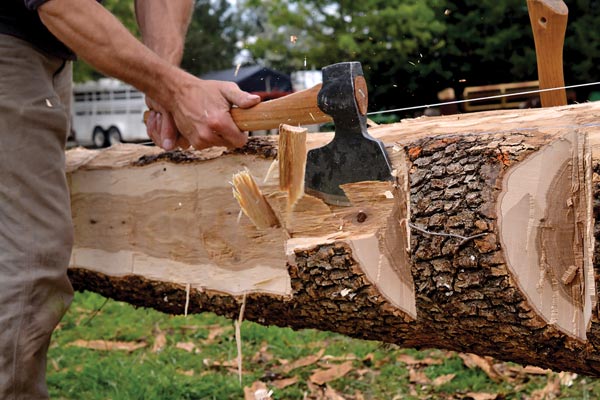
“I am hewing the ridge beam for a log cabin that a friend and I are building from post oak, a native species of white oak.” —Jack Baumgartner
A key aspect of that living-together has to do with choosing what technology to use in their household. To characterize Baumgartner and his wife as anti-technology is to miss the point entirely: technology – tools and their right use – is something that Baumgartner regards as a great good. This good is a theme to which he returns again and again. He refers to his tools as “the technology of my worship. The axe is the perfect tool, as a woodworker. It is the tool. It is tool. Every woodworking tool is resting there in the axe, waiting to be born.” He hopes, he says, to be a craftsman in the line of Bezalel, the Old Testament character, who “fashioned so much for the tabernacle, making the sacred things that were part of the ‘technology’ of worship of his God for his community. Bezalel is a paradigm of an artisan of broad experience – he could work in many trades and arts with skill worthy of God’s tabernacle.”
Working with tools is the crucial way that he feeds his “hunger to see and participate with more of God in every particle of everything.” The technology he prefers does not insulate him from the concrete world but embeds him in it. He’s drawn to “thinking about and using ‘old’ technology,” he says on his website, “where I can really see and feel the principles at work. Where I can experience the relationship of design and purpose in my hands. The partnership of a wedge and lever in a well-made axe is filled with grace and wonder. So it goes with many tools: a moldboard plow, a scythe, or a block and tackle.”
Baumgartner rejects the separation between the theoretical and practical, between knowledge and know-how. “I can’t stand education I can’t do something with,” he says. “I can only study so much before I am outside working again, putting things into application. I am glad I am seeing those traits in my children. You read about something, then you try to build it yourself, or make it happen. We can do darn near anything around here with tools and knowledge. Everyone who comes to our farm knows that we love tools, and knows that my kids learn to use them as soon as they are able.”
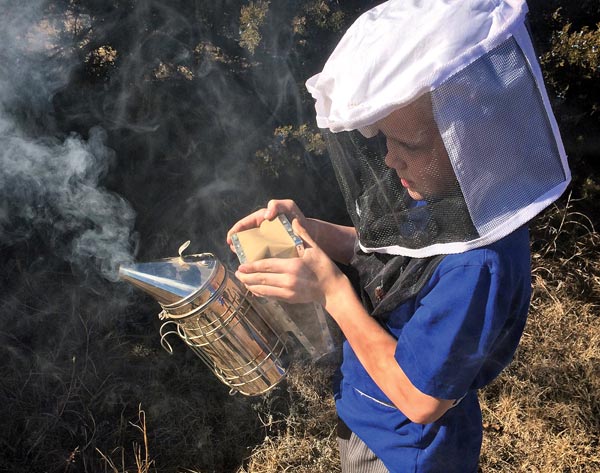
“We keep some honey bees in top bar hives. I have a few extra veils so that the kids can come out with me when I am checking them. Operating the smoker is quite naturally a popular job.” —Jack Baumgartner
The skills that he’s passing down to his children are not separable from the faith that he is likewise passing down. Raised Presbyterian, he says that his father’s and grandfathers’ presence in his life led him to have a strong sense of God as a present father. “My granddad was a gifted woodcarver,” he explains, “and I spent a lot of time with him in his workshop. My dad, too, is a builder and carver, so the weekends and summers were often spent making things.”
Having received skills and faith from others, Baumgartner feels accountable to pass them on. On one November evening, he told me, his ten-year-old son “turned a carving mallet out of Osage orange on the lathe. He was constantly calling me over to talk about all of the details he was noticing in the wood, all the nuances of its beauty. He finished the piece with excellence, leaving no rough spots, no tool marks, and no scratches from the heavier grits of sandpaper. He is no master yet, far from it, but he is on the path that will take him there if he wants to go.”

“My oldest son Obediah is turning a small wooden top on the lathe. The wood is cherry.” —Jack Baumgartner
Baumgartner is also passing these skills on to those beyond his family. Recently, a young man contacted him, an aspiring woodworker looking for mentoring. He’s moved into their household for the duration of his informal apprenticeship. “I am passing on to one who is hungry for them lessons I learned from my dad and granddad, and my own lessons as well. I am teaching him how to hold his body when he saws, how to be conscious of his grip when he concentrates. How to intuitively feel when a tool is square as it meets the wood.”
Despite his commitment to traditional tools, Baumgartner is no Luddite. When his youngest son was twenty-one days old, he began to show symptoms of a lymphatic disorder. Modern medicine saved the baby’s life. Meanwhile, Baumgartner’s father is on the list for an organ transplant. “I watched modern medicine save the two living bookends of my family,” he says. “And I was confident that I was watching God display his goodness, and I was confident that I was missing a lot of the picture. But the line of stewardship, I could see.”
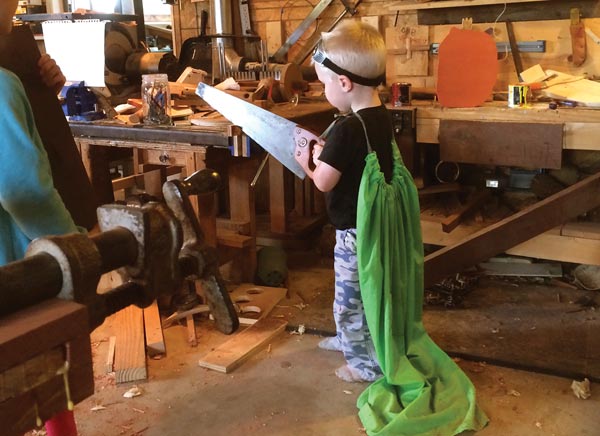
“My kids have their own benches and tools to work with. We value the spiritual and practical principles of problem-solving and stewardship. Here, my son Ezra is helping to build a rubber-band-powered paddle boat, donned in a superhero cape made by his grandmother.” —Jack Baumgartner
This line of stewardship is the mandate that we have to work in the material world. God can perform healing miracles, as he can perform miracles of the multiplication of bread, of fish, of wine. But he doesn’t always do so. Baumgartner believes that “God invited us to be a part of the world He created and [in which he] hid away countless treasures for us to unlock and grow.”
He and his wife have not made a single, ideologically driven choice to reject something called “modern technology.” Instead, they’ve made a series of choices to do and make and play and work together. “We cure our own hams and bacon. We don’t take vacations. We go into debt to buy a farm. We let our children work with knives. We get shit on our hands and feet and track it in the house. We grow wheat and harvest it with sickles and scythes, thresh it and winnow it by hand, grind it by hand. We break lots of things. We fix lots of things, but not as many as we break. We sing, we dance, we fight. We are like the rest of the whole world. We grow our own food and we like Skittles.”
They are crafting their family, their days, to make something of lasting value. And they’re attempting to choose, in each case, the right tool for the job.
Photography courtesy of Jack Baumgartner
Already a subscriber? Sign in
Try 3 months of unlimited access. Start your FREE TRIAL today. Cancel anytime.






































Mary Alean Scott
Great article...family is EVERYTHING! GOD in the CENTER of FAMILY or shall l say...AT THE TOP...IS POWERFUL so Family-Life can be FRUITFUL! Really enjoyed reading about this family's journey.